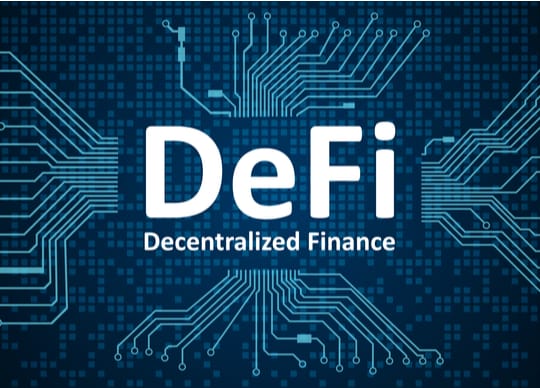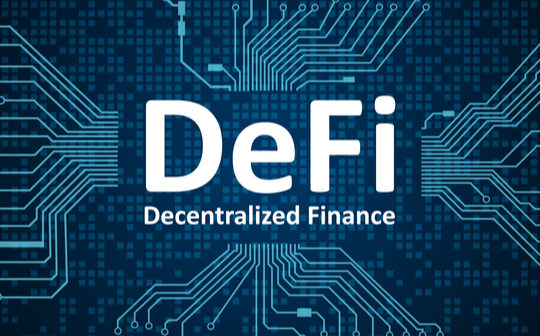
Basics of DeFi
Decentralized Finance or “DeFi” is an umbrella term encompassing the vision of a financial system that functions without any intermediaries, such as banks, insurances, or clearinghouses, and is operated just by the power of smart contracts. DeFi applications strive to fulfil traditional finance services (also called Centralized Finance, or just CeFi) entirely permissionless, global, and transparent.
DeFi is likely to have a substantial impact on how banks function in the future and even can shift the structure of the whole financial system at a macroeconomic level.
DeFi challenging traditional finance actors
Since its inception, the vision of a new financial system has accompanied the blockchain space, and it’s been an aspirational dream for the blockchain community.
Past two years, DeFi has grown astonishingly, and billions of USD have gone into ecosystem development. In the following, you will see the comparison with conventional banking systems and an overview of the actors in the DeFi ecosystem to provide a clear context on how DeFi is reducing the gap over traditional banking.
Conventional Banking vs DeFi — Comparison
A quick look into the traditional banking vs DeFi based protocols; this data will help you understand how DeFi is snowballing.
| Services | Conventional Banking | DeFi |
| Commercial Banks | Borrowing and lending are the basic building blocks of an effective financial system. The main business of commercial banks is to receive deposits and give loans to their clients. As holders of funds get an incentive to provide liquidity to the markets and, in exchange, earn a return on their otherwise unproductive assets. | DeFi protocols enable for the first time to borrow or lend money on a large scale between unknown participants and without any intermediaries. Those applications bring lenders and borrowers together and set interest rates automatically following supply and demand.
The recent hype around DeFi applications is due to borrowing and lending protocols, such as Compound. In contrast to traditional finance, loans in DeFi are secure by over-collateralization. However, companies such as Aave are currently working on enabling uncollateralized loans similarly to conventional finance. |
| Investment Banks | The business model of investment banks usually involves the advisory on financial transactions. Also, the creation or trading of complex financial products and the management of assets fall in the realm of investment banks. | DeFi protocols are already offering similar products. For instance, Synthetix is a derivatives issuance protocol, enabling the decentralized creation and trading of derivatives on assets such as stocks, currencies, and commodities. Also, decentral asset management for cryptocurrencies is evolving. Yearn Finance, for example, is an autonomous protocol that searches for the best yields in the DeFi space and invests automatically for its users. |
| Exchanges | An exchange function organizes different assets, such as stocks or foreign currencies, between two or more market participants. | The centralized exchanges (CeFi) like Coinbase or Binance offer to swap a cryptocurrency unit against another.
With the emergence of decentralized exchanges (DEX), holders of cryptocurrencies no longer need to leave the crypto space to swap their tokens. A prominent example of a DEX is Uniswap, and DEX is composed of smart contracts that hold liquidity reserves and function according to defined pricing mechanisms. Such automated liquidity protocols play a crucial role in developing an independent decentralized ecosystem without CeFi intermediaries. |
| Insurance | An essential function of insurance is to smooth out risks and bring security to market participants | An example of decentralized insurance is Nexus Mutual, which offers insurances that cover bugs in smart contracts. Considering everything is based on smart contracts in DeFi, vulnerabilities in smart contracts are a real risk for DeFi users. Decentralized insurances are still in their infancy, but a more significant amount and more sophisticated insurance models can emerge in the DeFi space in the future. |
| Central Banks | Central banks carry out a nation’s monetary policy and control its money supply, often mandated with maintaining low inflation and steady GDP growth. On a macro basis, central banks influence interest rates and participate in open market operations to control the cost of borrowing and lending throughout an economy. | Stablecoins are on blockchain protocols that have the principle of price stability inherently encoded and, thus, fulfil the function of a reserve currency. The introduction of stablecoins set the foundation of the functioning decentralized financial system, as they enable participants to engage with each other without the underlying risk of price volatility. There are three options for how a cryptocurrency can reach price stability.
1) Stablecoins can reach high degrees of price stability by pegging a currency to other assets. For example, for each issued unit of USD Coin, a real US Dollar is held in reserve.
2) From a decentralized finance perspective, another interesting approach is the issuance of stablecoins by using other cryptocurrencies as collateral. A leading protocol for the DeFi stablecoin ecosystem is Maker DAO, which issues the DAI cryptocurrency and ensures with its algorithm that the value of 1 DAI is hovering around the value of 1 US Dollar. 3) More experimental approaches aim to reach price stability without collaterals. For instance, the protocol Ampleforth automatically adjusts the supply of tokens based on the demand. |
DeFi will outperform the traditional finance system in the future
There are three reasons why DeFi has the potential to outperform the conventional financial system and gain increasing attention in scientific, economic, and public debates:
- Speed of growth: DeFi is a highly scalable and global ecosystem. Once DeFi as a whole (or a specific DeFi application) proves its utility, exponential growth is possible. DeFi Pulse monitors the total value locked (TVL) on smart contracts on all relevant DeFi applications.
- Room for growth: According to Messari, a crypto market analytics firm, the capitalization of all DeFi applications was just 5% of the total crypto market as of July 2020. In addition to that, we can argue that there is much room for growth only by further asset redistributions within just the crypto space.
- Newmarket segments: According to The World Bank,7 billion adults do not have access to banking services. DeFi is permissionless, meaning that anyone can access those financial services anywhere. In principle, just electricity, an internet connection, and smartphones are sufficient. DeFi could provide a viable option in regions where banking services are too expensive compared to income.
Conclusion: DeFi is here to stay
For the first time in history, a financial system is developing without intermediaries at a large scale. So far, DeFi applications cannot compete in terms of security, speed, and ease of use with traditional finance solutions yet. But DeFi has produced real, working applications that have already attracted billions of capital. Those resources will be used to develop more competitive and user-friendly applications.
About the Author:
Vinoth is a cybersecurity professional by heart with over two decades of experience in Information Technology and Cybersecurity. He is an Australian Computer Society (ACS) Senior Certified Professional in Cybersecurity and holds various industry-leading cybersecurity credentials. Vinoth loves to write about the latest cybersecurity happenings and blockchain-related articles.





